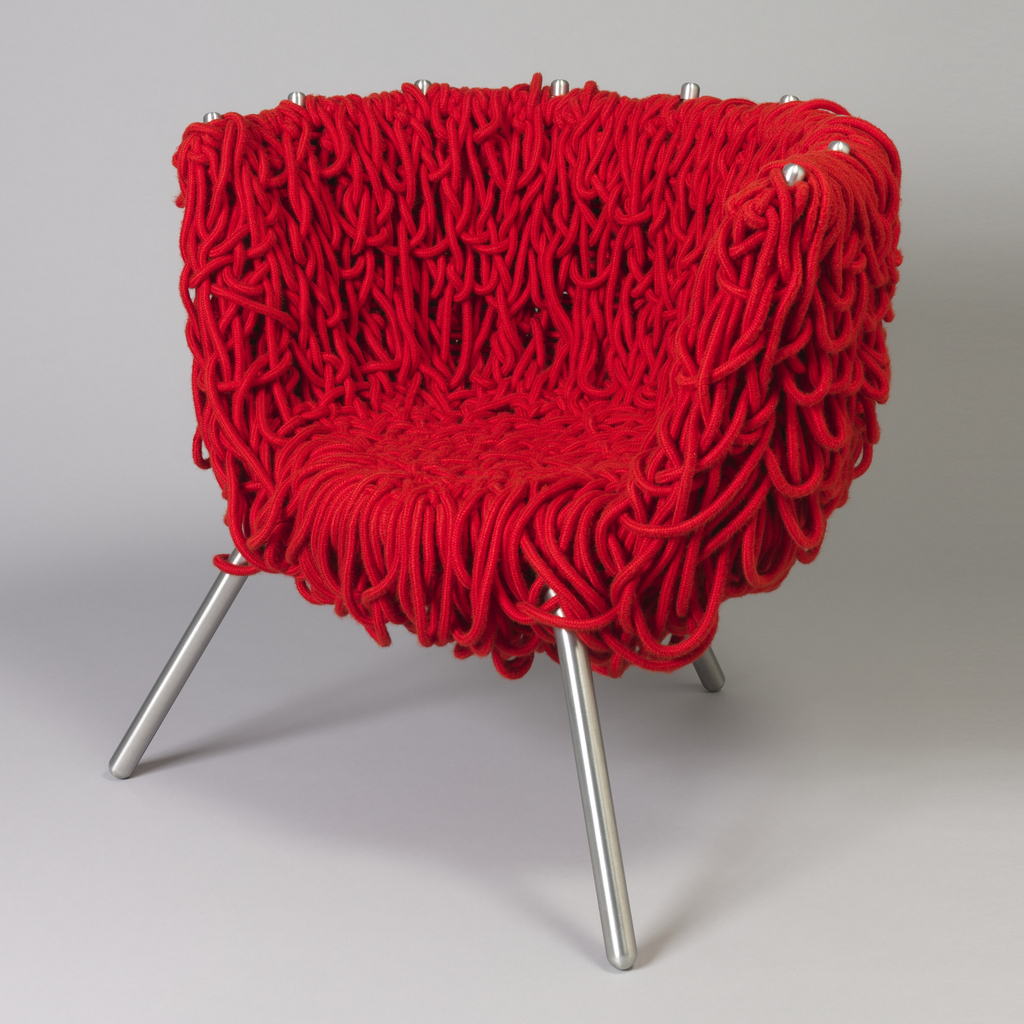Vermelha, Portuguese for “red”, comes from the Latin vermiculus, or “little worm”, in reference to the Kermes vermilio, a scale insect used to make the color crimson. This is the source of the Vermelha Chair’s name, a vibrant, brightening shade of red that is both jarring and mesmerizing. Designed by Brazilian designers – and brothers – Fernando and Humberto Campana, the Vermelha chair is not an art piece, but a design that caught the eye of Italian brand Edra’s creative director Massimo Morozzi. It seems fitting that Edra was the company who was enchanted by the chair and its potential as a piece for furniture design. The name “Edra” is a modification of the Greek word “έδρα”, meaning a place for philosophical discussion. While the Campana brothers had encountered a myriad of people who saw it only as an art piece, Morozzi took the design a step further and made it into one of Edra’s best sellers, a long way from the brothers selling a mere five chairs between 1993 and 1998. It was no longer just art, but was transformed into a seat for mass production.
The success of the Campana brothers has helped with the development of a new identity for Brazilian design to illustrate that local culture and habits do not have to be sacrificed for a global product. Humberto described the chair as an homage to chaos – a portrait of Brazil, a melting pot of culture, race, and something fragmented. Neither brother began their career with an end goal in design – Humberto initially studied law and Fernando architecture. Their collaboration began after Humberto drew inspiration for an iron chair with a swirling design from a near-death experience in the Grand Canyon, and Fernando improved upon it.(1)
They began to bring more industrialized elements into their designs after starting with more functional sculptures.
The Vermelha chair is composed of over four hundred and fifty meters of rope, all woven together in an imprecise way. The brothers sent a video to Edra to demonstrate the construction process. Edra loved it, despite the process being a very primitive one to translate into commercial production. The rope is first woven onto a frame to create a structure, and then plaited by consecutive overlapping, leaving sufficient surplus to form a random weave which creates the chair’s unusual padding. (2) This handmade process is extremely time-intensive, and requires several days’ work by a single person with high expertise in Brazilian weaving. The use of cord to create the opulent pile upholstery was part of the brothers’ goal to evoke the rich street-market culture of Brazil in their work. As part of Brazilian gambiarra, the chair is a response to a spontaneous and makeshift style of problem solving – an unlikely mend or unthinkable coupling. (3) The challenge is to transform something poor into something opulent. Humberto heavily credits his Brazilian heritage as a foundation to their designs, believing that Brazil “forces you to develop a mental agility, because of its ups and downs.” (4) Whether the brothers’ furniture is produced by the Campana Studio, Edra, or another company, the pieces are completed by craftsmen who hand-finish the industrially produced components with tied, draped, or woven materials, and give Brazilian crafts an outlet to the world.(5)
1. Vik Muniz, “Campana Brothers,” BOMB – Artists in Conversation, http://bombmagazine.org/article/3040/campana-brothers
2. Edra S.p.A Catalogue, “Vermelha: Fernando e Humberto Campana, 1993-98”, 52.
3. Vik Muniz, “Campana Brothers,” BOMB – Artists in Conversation, http://bombmagazine.org/article/3040/campana-brothers
4. Vik Muniz, “Campana Brothers,” BOMB – Artists in Conversation, http://bombmagazine.org/article/3040/campana-brothers
5. Financial Times, March 10/March 11, 2007, p. 9.
The Vermelha Chair was featured in the exhibition The Campana Brothers Selects: Works From the Permanent Collection, on display at Cooper Hewitt Smithsonian Design Museum from February 15–September 28, 2008.
Erin Benedictson is an intern in the Product Design and Decorative Arts department at Cooper Hewitt, Smithsonian Design Museum.
